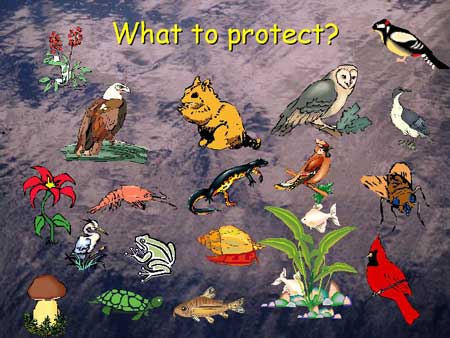Ecological Risk Assessment Step 3
Sections of Step 3 Baseline ERA (BERA) Problem Formulation:
If the Screening-Level Ecological Risk Assessment indicated a need for further study, the assessment process should proceed to Step 3: Baseline Problem Formulation.
Refining Contaminants of Potential Ecological Concern (COPECs)
In this phase, the conservative assumptions used in the Screening Level Ecological Risk Assessment (SLERA) should be replaced with more realistic assumptions.
Decisions about whether or not chemicals should be eliminated from further consideration should be made about contaminants for which their respective Hazard Quotients (HQs) are at or are below one.
Some considerations are as follows. First, in Steps 1 and 2 it is important to note only whether or not the maximum concentration of a chemical exceeds its respective screening number. Step 3 is part of the first step in the Baseline Ecological Risk Assessment (BERA). Second, although comparisons to background concentrations should not be made in the SLERA, they may be done in the BERA, if there is sufficient information known about the BACKGROUND levels of chemicals. Third, Contaminants of Potential Ecological Concern (COPECs) with HQs of one, or near one, should be examined closely to determine if they truly do pose risk and if there are other contaminants that pose greater risk, which could drive the cleanup process. Finally, additional descriptions of ecological effects by contaminants should be done.
Comparisons to Background Concentrations/Reference Locations
While comparisons of contaminant concentrations in the media at the site being investigated to concentrations of contaminants at reference or background locations MAY be done, there are several restrictions on the application of this line of evidence.
First, this comparison should NOT be done in the Screening Level Ecological Risk Assessment (Steps 1 and 2).
Second, if the concentration of a contaminant at the site exceeds its respective screening benchmark, it MUST be further evaluated in the Baseline (Steps 3 to 8) portion of the Ecological Risk Assessment. This further evaluation must be done even if the concentration of the contaminant at the site does not exceed background levels. This is because there is still the potential for risk due to direct toxicity or bioaccumulation.
U.S. EPA (2002) (click here to link to the full guidance document on the application of background comparisons) recommends a baseline risk assessment in which contaminants with concentrations that exceed risk-based screening criteria are retained for further analysis. "This approach involves addressing site-specific background issues at the end of the risk assessment, in the risk characterization. Specifically, the COPECs [Contaminants of Potential Concern] with high background concentrations should be discussed in the risk characterization, and if data are available, the contribution of background to site concentrations should be distinguished. COPECs that have both release-related and background-related sources should be included in the risk assessment."
"The COPECs retained in the quantitative risk assessment should include those hazardous substances, pollutants, and contaminants with concentrations that exceed risk-based screening levels."
U.S. EPA (2001) (click here to link to the full EcoUpdate document on refining COPECs) also states the following when considering comparisons to background:
- If, however, any contaminants are identified for exclusion from the baseline ERA through application of any or all of the three supplemental components described herein [including comparisons to concentrations in background samples, low frequency of detection, and dietary considerations], it is essential to evaluate bioaccumulation, biomagnification, and bioconcentration of each such contaminant as well.
- While contaminants of concern may be removed from further assessment through comparison with toxicological benchmarks, comparison with background levels generally cannot be used to remove contaminants of concern owing to the need to fully characterize site risk.
- Items that need to be discussed when considering background comparisons:
- Potential toxicity of any contaminants identified as below background (particularly when toxicity benchmarks are lacking or when contaminants exceed toxicity benchmarks);
- Potential for adverse effects caused by interactions between chemicals considered as background and those COPECs to be further investigated;
- Discussion of all criteria by which contaminants are considered
either background or site-related.
Third, in order for background comparisons to be done, the background area should be chosen with the assent of the U.S. EPA regional risk assessor and it should be adequately characterized.
Magnitude of Exceedences and Frequency of Detection
-
While COPECs may be eliminated from further evaluation due to low frequencies
of detection, U.S.
EPA (2001) describes the following issues that should be discussed
when frequency of detection is an issue. Note: these also apply to magnitude
of exceedence (i.e., by how much does the contaminant concentration exceed
its respective screening benchmark):
- Influence of random and/or biased sampling on the frequency and magnitude of detected values within the distribution of data;
- Spatial and temporal pattern of contaminants identified as low frequency and/or low magnitude;
- Comparison of risk-based detection limits with toxicity benchmarks;
- Relationship of detected values to toxicity benchmarks;
- Potential for bioaccumulation, biomagnifications, and bioconcentration.
Additionally, as mentioned in Step 2, there are no established standards for determining the level of risk from a contaminant at a site from how much the contaminant concentration exceeds its respective screening benchmark. Thus, this line of evidence is not typically used in Ecological Risk Assessments, especially without other lines of evidence (however, please consult with your regional risk assessor for additional guidance in this area).
Dietary Considerations
A number of chemicals that may be site-related function as nutrients in organisms serving as physiological electrolytes, such as calcium, iron, magnesium, sodium, and potassium [U.S. EPA (2001)]. When present at concentrations that allow them to function in this manner, they typically pose little ecological risk. Conversely, nutrients such as selenium, copper, molybdenum, and boron, can change from essential to toxic at only slightly higher concentrations.
-
Issues that should be discussed:
- The group of nutrients relevant to the range of ecological receptors (wildlife and plants) being considered at the site;
- The potential for toxic effects resulting from site concentrations in comparison to the toxicological benchmarks for nutrients;
- Whether contaminant interactions may result in a nutrient deficiency for organisms of concern; and
- Whether the nutrient deficiency level and the toxicity benchmark are similar in magnitude.
Contaminant Fate & Transport
Definition: the environmental fate and transport of the contaminants - This is how contaminants are taken up by plants and animals; how they are transferred among plants and animals (i.e., through animals eating plants or other animals); how the contaminants affect plants and animals (see Toxicity Effects); how the chemical contaminants might move through, or be transformed physically, chemically, and biologically in the environment; and how the contaminants are eliminated from plants and animals.
Chemical processes that might affect contaminants include:
- Degradation:
The process of breaking down of a compound by stages, with each stage a well-defined compound in itself; - Ionization:
The change in a contaminants via the formation of ions (charged atoms) by separating atoms or molecules; or by adding or subtracting electrons from atoms by strong electric fields in a gas; - Precipitation:
The process of formation of solids from substances dissolved in a liquid; - Adsorption:
The accumulation of gases, liquids, or solutes on the surface of a solid or liquid (e.g., particles of contaminants attaching to sediment or soil particles); - Complexation:
The process by which metals form complexes with dissolved substances such as organic carbon, thus potentially changing the bioavailability of the metals.
Physical processes that might affect contaminants include:
- Volatilization:
Evaporation; - Erosion:
The group of natural processes, including weathering, corrosion, and transportation, by which material is worn away from Earth's surface; - Deposition:
The laying down of material; - Weather of parent material:
A type of erosion that results in new substances being formed; - Water transport:
- in solution - particles are dissolved in the water (e.g., salt water);
- suspended material - particles are in the water, but are not dissolved (e.g., muddy water);
- bulk transport of solid material - large pieces or clumps of material being moved by water currents.
Biological processes that might affect contaminants (biotransformation) include:
- Bioaccumulation:
The process by which the levels of contamination increases in the tissues of a plant or animal, and how the levels of the contamination changes (generally increases) as it passes through the food chain; - Biodegradation:
T he breakdown of chemicals via biological processes; - Biological transformation:
T he change(s) in a chemical via biological processes, but not necessarily a breakdown of the chemical; - Food chain transfers:
The exchange of contaminants between plants and animals or between animals and animals during consumption; can also be from an inorganic substances (soil, sediment, water, etc.) to a plant or animal; - Excretion:
The elimination of contaminants from a plant or animals through waste products (e.g., urine, feces).
Mechanisms of Ecotoxicity
A contaminant can cause adverse ecological effects in many ways. First, a Contaminant of Potential Ecological Concern (COPEC) might affect a plant and animal after exposure for a short period of time (acute) or after a long period of time (chronic). Second, the effect of a COPEC might be lethal (killing the plant or animal) or sublethal (causing harmful effects other than death, such as reduced growth, reproduction, or life-span, behavioral changes, etc.). Third, a COPEC might act directly (lethal or sublethal effects) or indirectly (through damaging food sources or habitat, or altering predator-prey relationships or competition between species) on a plant or animal (see Toxicity Effects for information on specific chemical contaminants).
Ecosystems at Risk
Definition: Ecosystems at Risk - the ecological/environmental setting and animals and plants found at the site (including habitat, animals or plants potentially exposed to contaminants, etc.).
Because some groups of plants or animals can be more sensitive than others to a particular contaminant, available information on ecological effects of contaminants can help focus the investigation on specific ecological resources (plants, animals, habitat types) that should be evaluated more thoroughly. The following questions should be answered:
- What habitats are present?
- What types of water bodies are present?
- What species of plants and animals can be found at the site?
- How sensitive are the different species to chemical contamination?
It should be noted that there can be both variation in sensitivity to
contaminants and variation in exposure, and these should not be confused.
- Some species are more sensitive to some chemicals;
- Predators can become more highly exposed to Contaminants of Potential Ecological Concern (COPECs) through biomagnification in the food chain or from feeding more often (or exclusively) on a specific type of prey that accumulates contaminants more easily than other prey types;
- Species may prefer to feed in or be active in contaminated (or non-contaminated) areas.
All of these factors must be considered when refining exposure pathways.
Figure 1. Aquatic Habitat

Figure 2. Different types of plants and animals that may be found at Superfund sites.

Complete Exposure Pathways
Definition: Complete Exposure Pathway - how contaminants pass through an ecosystem from the source to the receptors. For example: a contaminant might pass from sediment to surface water to a fish via the fish's gills (complete pathway is sediment to surface water to gill to fish body).
For specific contaminants, it is frequently possible to reduce the number
of exposure pathways that need to be evaluated to one or a few critical
exposure pathways. These especially important means of exposure
(1) reflect very high levels of exposure of contaminants to plants and
animals, and (2) make up exposure
pathways to plants and animals that are exceptionally sensitive to
the contaminant(s). Multiple critical exposure pathways should all be
evaluated because it is often difficult to predict which pathways can
be responsible for the greatest ecological risk. As a group, these exposure
pathways make up the conceptual site model for the
site under investigation.
Figure 3. Terrestrial Animals (red fox) - Pathways include inhalation, ingestion, dermal contact

Figure 4. Fish - Pathways include ingestion (of prey items, sediment, and/or surface water) and direct contact with surface water

Figure 5. Terrestrial Plants - Pathways include root absorption and leaf deposition

Figure 6. Aquatic Plants - Pathways include direct contact with water and root absorption

Selection of Assessment Endpoints
Definition: Assessment Endpoint - "an explicit expression of the environmental value that is to be protected" (U.S. EPA 1997).
This definition refers to characteristics about a population, species, or group of species that can be measured and can be affected by an ecological stressor. The species or groups of species usually have some common characteristics, such as a specific exposure route or sensitivity to particular contaminants. Endpoints can be limited to single species.
In any case, selection of the endpoints should be based on the following criteria:
- Ecosystems, communities, and/or species potentially present at the site;
- Contaminants present and their concentrations;
- What are the harmful effects of the contaminants found at the site - this should include the following:
- what plants and animals could, or will, be at risk;
- how the plants and animals might be affected by the contaminants (i.e., what form of damage might the contaminants cause: lowered reproductive rates, tumors, slower growth, death, etc.);
- the chemical and physical form of the contaminants' influence;
- bioavailability;
- and the type and scale of any adverse responses by the plants and animals that are potentially affected by the contaminants at the site;
- Plants or animals that are potentially sensitive, or highly exposed, to the contaminants and attributes of those groups' natural history;
- Exposure pathways - including if the contaminants affect plants and animals via direct contact/exposure with a particular medium (e.g., water or sediment) or indirect exposure through food chains, or both.
Broad assessment endpoints tend to be less valuable than more specific ones, but endpoints should not be too restrictive, either. Examples of assessment endpoints are (1) reproduction of piscivorous (fish-eating) birds or (2) survival of benthic invertebrate communities. Once assessment endpoints have been selected, questions and measurement endpoints can be developed to determine whether or not a potential threat to the assessment endpoints exists.
Sensitivity to Contaminants of Potential Ecological Concern (COPECs)
Additional information to consider when selecting measurement endpoints is the physiological, behavioral, or life-history characteristics of the species that make that species useful in evaluating the effects of site-specific contaminants [See Contaminants of Potential Ecological Concern (COPECs)]. For example, some species are particularly sensitive to contaminants, such as mink which are highly sensitive to PCBs.
Conceptual Site Model
The Conceptual Site Model (CSM) describes/diagrams the complete exposure pathways that will be evaluated in the Ecological Risk Assessment and the relationship of the measures of effect to the assessment endpoints. In the CSM, the exposure pathways are normally depicted in a diagram and must reflect the assessment endpoints previously described. The intent of the CSM is not to describe a particular species or site exactly; instead, it is to be a more general description of the possible ways that plants and animals might become exposed to contaminants at the site, especially where specific information is lacking. The following are three different, but equally acceptable, types of conceptual site models. Other forms or types can include tables.
Figure 8. Second Example of Aquatic Conceptual Site Model
Figure 9. Joliet Army Ammunition Planet Conceptual Site Model
Risk Questions
Ecological risk questions for the Baseline Ecological Risk Assessment (BERA) at Superfund sites are basically questions about the relationships among assessment endpoints and their expected responses when exposed to contaminants. In other words, "does chemical X cause harmful effects in assessment endpoint Y?". These questions use measurement endpoints to answer that question for each assessment endpoint that have been chosen in this step. These five lines of evidence are appropriate for answering ecological risk questions:
- Comparisons of estimated or measured exposure levels for a particular chemical against screening levels that are known from the literature to be toxic to the plants and animals selected as assessment endpoints;
- Comparisons of laboratory tests (bioassays) with media (soil, sediment, water) from the site;
- Comparisons of laboratory tests against media from a reference site;
- Comparisons of in situ toxicity tests at the contaminated site with in situ toxicity tests in a reference site;
- Comparisons of observed effects in the plants and animals associated with the site with similar plants and animals at a reference site.
Scientific-Management Decision Point
At the conclusion of this step, there is a Scientific-Management Decision Point (SMDP). The SMDP consists of agreement on four items: contaminants of concern, assessment endpoints, exposure pathways, and risk questions. Those items can be summarized with the assistance of the Conceptual Site Model (CSM). Without agreement between the risk manager, risk assessor, and other involved professionals on the CSM to this point, measurement endpoints cannot be selected, and a site study cannot be developed effectively.
![[logo] US EPA](../gif/logo_epaseal.gif)


